Fangneng Zhan
Visual Acoustic Fields
Apr 01, 2025Abstract:Objects produce different sounds when hit, and humans can intuitively infer how an object might sound based on its appearance and material properties. Inspired by this intuition, we propose Visual Acoustic Fields, a framework that bridges hitting sounds and visual signals within a 3D space using 3D Gaussian Splatting (3DGS). Our approach features two key modules: sound generation and sound localization. The sound generation module leverages a conditional diffusion model, which takes multiscale features rendered from a feature-augmented 3DGS to generate realistic hitting sounds. Meanwhile, the sound localization module enables querying the 3D scene, represented by the feature-augmented 3DGS, to localize hitting positions based on the sound sources. To support this framework, we introduce a novel pipeline for collecting scene-level visual-sound sample pairs, achieving alignment between captured images, impact locations, and corresponding sounds. To the best of our knowledge, this is the first dataset to connect visual and acoustic signals in a 3D context. Extensive experiments on our dataset demonstrate the effectiveness of Visual Acoustic Fields in generating plausible impact sounds and accurately localizing impact sources. Our project page is at https://yuelei0428.github.io/projects/Visual-Acoustic-Fields/.
SOGS: Second-Order Anchor for Advanced 3D Gaussian Splatting
Mar 10, 2025Abstract:Anchor-based 3D Gaussian splatting (3D-GS) exploits anchor features in 3D Gaussian prediction, which has achieved impressive 3D rendering quality with reduced Gaussian redundancy. On the other hand, it often encounters the dilemma among anchor features, model size, and rendering quality - large anchor features lead to large 3D models and high-quality rendering whereas reducing anchor features degrades Gaussian attribute prediction which leads to clear artifacts in the rendered textures and geometries. We design SOGS, an anchor-based 3D-GS technique that introduces second-order anchors to achieve superior rendering quality and reduced anchor features and model size simultaneously. Specifically, SOGS incorporates covariance-based second-order statistics and correlation across feature dimensions to augment features within each anchor, compensating for the reduced feature size and improving rendering quality effectively. In addition, it introduces a selective gradient loss to enhance the optimization of scene textures and scene geometries, leading to high-quality rendering with small anchor features. Extensive experiments over multiple widely adopted benchmarks show that SOGS achieves superior rendering quality in novel view synthesis with clearly reduced model size.
DiffAge3D: Diffusion-based 3D-aware Face Aging
Aug 28, 2024

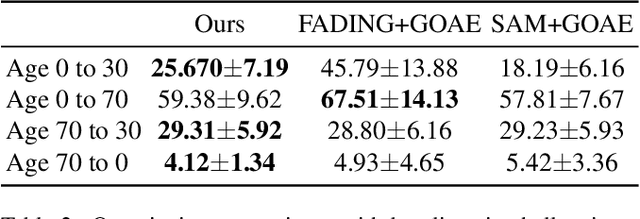
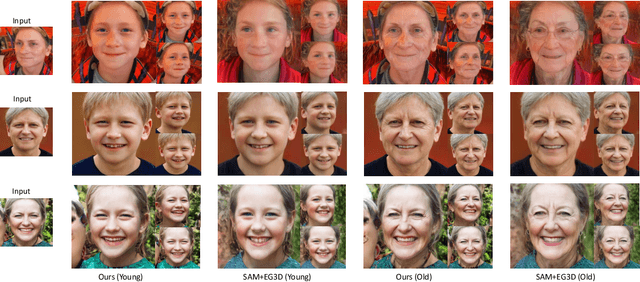
Abstract:Face aging is the process of converting an individual's appearance to a younger or older version of themselves. Existing face aging techniques have been limited to 2D settings, which often weaken their applications as there is a growing demand for 3D face modeling. Moreover, existing aging methods struggle to perform faithful aging, maintain identity, and retain the fine details of the input images. Given these limitations and the need for a 3D-aware aging method, we propose DiffAge3D, the first 3D-aware aging framework that not only performs faithful aging and identity preservation but also operates in a 3D setting. Our aging framework allows to model the aging and camera pose separately by only taking a single image with a target age. Our framework includes a robust 3D-aware aging dataset generation pipeline by utilizing a pre-trained 3D GAN and the rich text embedding capabilities within CLIP model. Notably, we do not employ any inversion bottleneck in dataset generation. Instead, we randomly generate training samples from the latent space of 3D GAN, allowing us to manipulate the rich latent space of GAN to generate ages even with large gaps. With the generated dataset, we train a viewpoint-aware diffusion-based aging model to control the camera pose and facial age. Through quantitative and qualitative evaluations, we demonstrate that DiffAge3D outperforms existing methods, particularly in multiview-consistent aging and fine details preservation.
Lite2Relight: 3D-aware Single Image Portrait Relighting
Jul 15, 2024
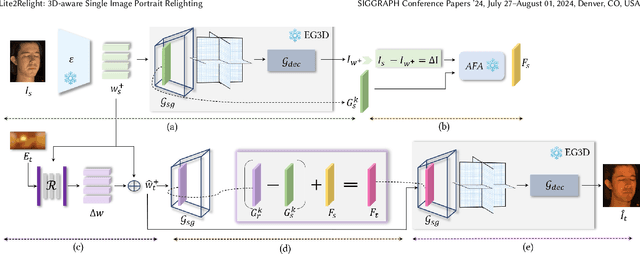
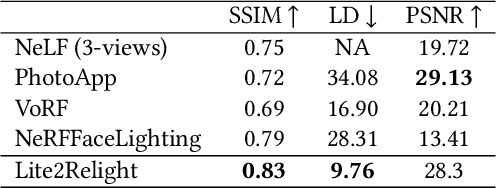
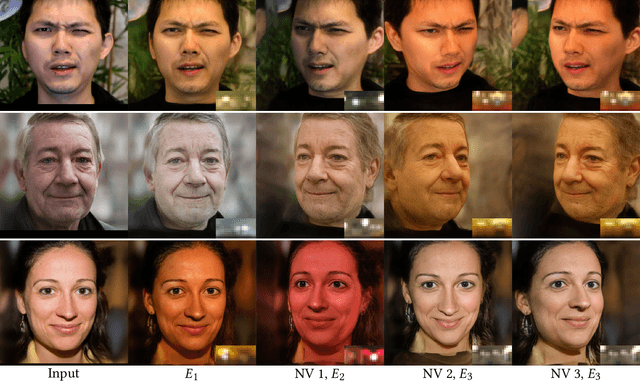
Abstract:Achieving photorealistic 3D view synthesis and relighting of human portraits is pivotal for advancing AR/VR applications. Existing methodologies in portrait relighting demonstrate substantial limitations in terms of generalization and 3D consistency, coupled with inaccuracies in physically realistic lighting and identity preservation. Furthermore, personalization from a single view is difficult to achieve and often requires multiview images during the testing phase or involves slow optimization processes. This paper introduces Lite2Relight, a novel technique that can predict 3D consistent head poses of portraits while performing physically plausible light editing at interactive speed. Our method uniquely extends the generative capabilities and efficient volumetric representation of EG3D, leveraging a lightstage dataset to implicitly disentangle face reflectance and perform relighting under target HDRI environment maps. By utilizing a pre-trained geometry-aware encoder and a feature alignment module, we map input images into a relightable 3D space, enhancing them with a strong face geometry and reflectance prior. Through extensive quantitative and qualitative evaluations, we show that our method outperforms the state-of-the-art methods in terms of efficacy, photorealism, and practical application. This includes producing 3D-consistent results of the full head, including hair, eyes, and expressions. Lite2Relight paves the way for large-scale adoption of photorealistic portrait editing in various domains, offering a robust, interactive solution to a previously constrained problem. Project page: https://vcai.mpi-inf.mpg.de/projects/Lite2Relight/
Evolutive Rendering Models
May 27, 2024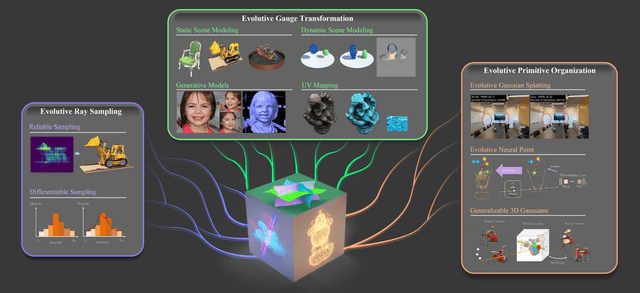
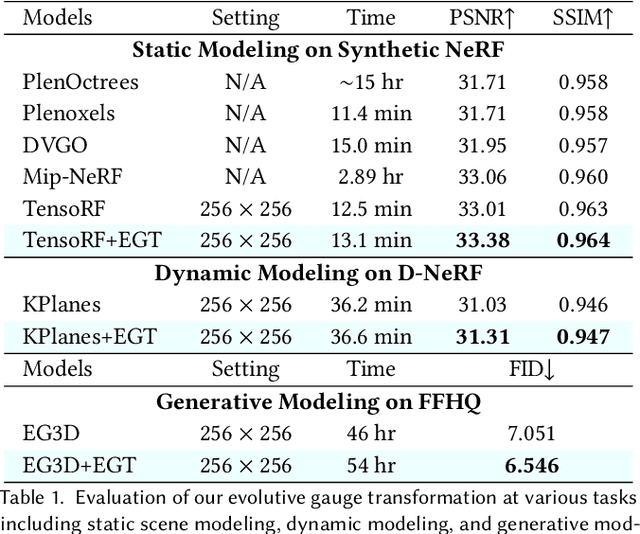
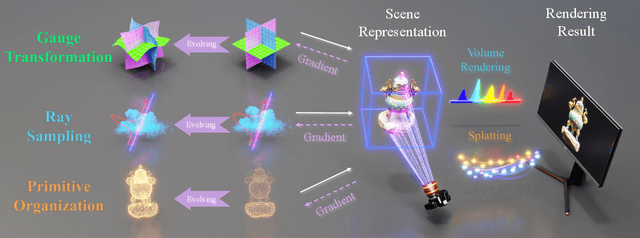

Abstract:The landscape of computer graphics has undergone significant transformations with the recent advances of differentiable rendering models. These rendering models often rely on heuristic designs that may not fully align with the final rendering objectives. We address this gap by pioneering \textit{evolutive rendering models}, a methodology where rendering models possess the ability to evolve and adapt dynamically throughout the rendering process. In particular, we present a comprehensive learning framework that enables the optimization of three principal rendering elements, including the gauge transformations, the ray sampling mechanisms, and the primitive organization. Central to this framework is the development of differentiable versions of these rendering elements, allowing for effective gradient backpropagation from the final rendering objectives. A detailed analysis of gradient characteristics is performed to facilitate a stable and goal-oriented elements evolution. Our extensive experiments demonstrate the large potential of evolutive rendering models for enhancing the rendering performance across various domains, including static and dynamic scene representations, generative modeling, and texture mapping.
Zero-Shot Video Semantic Segmentation based on Pre-Trained Diffusion Models
May 27, 2024Abstract:We introduce the first zero-shot approach for Video Semantic Segmentation (VSS) based on pre-trained diffusion models. A growing research direction attempts to employ diffusion models to perform downstream vision tasks by exploiting their deep understanding of image semantics. Yet, the majority of these approaches have focused on image-related tasks like semantic correspondence and segmentation, with less emphasis on video tasks such as VSS. Ideally, diffusion-based image semantic segmentation approaches can be applied to videos in a frame-by-frame manner. However, we find their performance on videos to be subpar due to the absence of any modeling of temporal information inherent in the video data. To this end, we tackle this problem and introduce a framework tailored for VSS based on pre-trained image and video diffusion models. We propose building a scene context model based on the diffusion features, where the model is autoregressively updated to adapt to scene changes. This context model predicts per-frame coarse segmentation maps that are temporally consistent. To refine these maps further, we propose a correspondence-based refinement strategy that aggregates predictions temporally, resulting in more confident predictions. Finally, we introduce a masked modulation approach to upsample the coarse maps to the full resolution at a high quality. Experiments show that our proposed approach outperforms existing zero-shot image semantic segmentation approaches significantly on various VSS benchmarks without any training or fine-tuning. Moreover, it rivals supervised VSS approaches on the VSPW dataset despite not being explicitly trained for VSS.
MixLight: Borrowing the Best of both Spherical Harmonics and Gaussian Models
Apr 19, 2024Abstract:Accurately estimating scene lighting is critical for applications such as mixed reality. Existing works estimate illumination by generating illumination maps or regressing illumination parameters. However, the method of generating illumination maps has poor generalization performance and parametric models such as Spherical Harmonic (SH) and Spherical Gaussian (SG) fall short in capturing high-frequency or low-frequency components. This paper presents MixLight, a joint model that utilizes the complementary characteristics of SH and SG to achieve a more complete illumination representation, which uses SH and SG to capture low-frequency ambient and high-frequency light sources respectively. In addition, a special spherical light source sparsemax (SLSparsemax) module that refers to the position and brightness relationship between spherical light sources is designed to improve their sparsity, which is significant but omitted by prior works. Extensive experiments demonstrate that MixLight surpasses state-of-the-art (SOTA) methods on multiple metrics. In addition, experiments on Web Dataset also show that MixLight as a parametric method has better generalization performance than non-parametric methods.
StyleGaussian: Instant 3D Style Transfer with Gaussian Splatting
Mar 12, 2024



Abstract:We introduce StyleGaussian, a novel 3D style transfer technique that allows instant transfer of any image's style to a 3D scene at 10 frames per second (fps). Leveraging 3D Gaussian Splatting (3DGS), StyleGaussian achieves style transfer without compromising its real-time rendering ability and multi-view consistency. It achieves instant style transfer with three steps: embedding, transfer, and decoding. Initially, 2D VGG scene features are embedded into reconstructed 3D Gaussians. Next, the embedded features are transformed according to a reference style image. Finally, the transformed features are decoded into the stylized RGB. StyleGaussian has two novel designs. The first is an efficient feature rendering strategy that first renders low-dimensional features and then maps them into high-dimensional features while embedding VGG features. It cuts the memory consumption significantly and enables 3DGS to render the high-dimensional memory-intensive features. The second is a K-nearest-neighbor-based 3D CNN. Working as the decoder for the stylized features, it eliminates the 2D CNN operations that compromise strict multi-view consistency. Extensive experiments show that StyleGaussian achieves instant 3D stylization with superior stylization quality while preserving real-time rendering and strict multi-view consistency. Project page: https://kunhao-liu.github.io/StyleGaussian/
FreGS: 3D Gaussian Splatting with Progressive Frequency Regularization
Mar 11, 2024


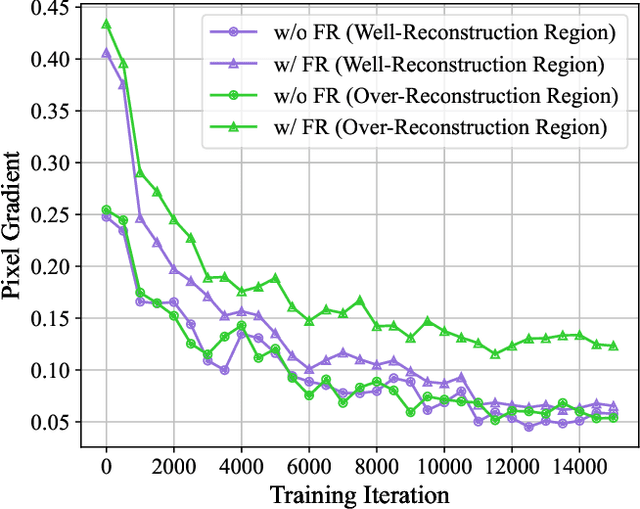
Abstract:3D Gaussian splatting has achieved very impressive performance in real-time novel view synthesis. However, it often suffers from over-reconstruction during Gaussian densification where high-variance image regions are covered by a few large Gaussians only, leading to blur and artifacts in the rendered images. We design a progressive frequency regularization (FreGS) technique to tackle the over-reconstruction issue within the frequency space. Specifically, FreGS performs coarse-to-fine Gaussian densification by exploiting low-to-high frequency components that can be easily extracted with low-pass and high-pass filters in the Fourier space. By minimizing the discrepancy between the frequency spectrum of the rendered image and the corresponding ground truth, it achieves high-quality Gaussian densification and alleviates the over-reconstruction of Gaussian splatting effectively. Experiments over multiple widely adopted benchmarks (e.g., Mip-NeRF360, Tanks-and-Temples and Deep Blending) show that FreGS achieves superior novel view synthesis and outperforms the state-of-the-art consistently.
TriHuman : A Real-time and Controllable Tri-plane Representation for Detailed Human Geometry and Appearance Synthesis
Dec 08, 2023Abstract:Creating controllable, photorealistic, and geometrically detailed digital doubles of real humans solely from video data is a key challenge in Computer Graphics and Vision, especially when real-time performance is required. Recent methods attach a neural radiance field (NeRF) to an articulated structure, e.g., a body model or a skeleton, to map points into a pose canonical space while conditioning the NeRF on the skeletal pose. These approaches typically parameterize the neural field with a multi-layer perceptron (MLP) leading to a slow runtime. To address this drawback, we propose TriHuman a novel human-tailored, deformable, and efficient tri-plane representation, which achieves real-time performance, state-of-the-art pose-controllable geometry synthesis as well as photorealistic rendering quality. At the core, we non-rigidly warp global ray samples into our undeformed tri-plane texture space, which effectively addresses the problem of global points being mapped to the same tri-plane locations. We then show how such a tri-plane feature representation can be conditioned on the skeletal motion to account for dynamic appearance and geometry changes. Our results demonstrate a clear step towards higher quality in terms of geometry and appearance modeling of humans as well as runtime performance.
 Add to Chrome
Add to Chrome Add to Firefox
Add to Firefox Add to Edge
Add to Edge